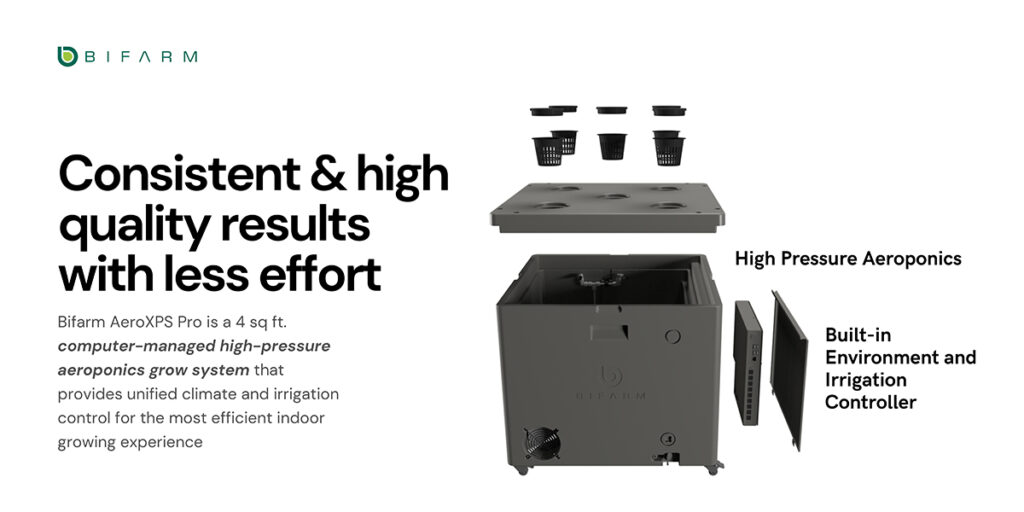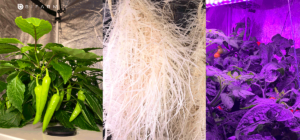
Aeroponics, especially High-Pressure Aeroponics (HPA), is a relatively new growing method. In High-Pressure Aeroponics systems, roots are suspended in the air and sprayed with an atomized solution of nutrients at specific intervals, while the rest of the plant is left to grow up and above the root chamber. This allows the roots to be exposed to more oxygen than traditional soil or hydroponics methods.
Increased oxygen exposure allows the plant's root system to flourish, and as a consequence plants' yields and quality increase, while they grow at a faster rate. It has been proven that High-Pressure Aeroponics shortens growth cycles by 25% or more. This methodology not only improves root strength and plant quality but the nutrient delivery in intervals conserves water and nutrients (up to 80%) compared to other methods. Growing aeroponically also provides the benefits of indoor growing: pest, temperature, humidity, and light management and control.
While HPA systems provide numerous benefits to growers, you might wonder why it is not widely adopted by growers. Plants tend to thrive in Aeroponics systems under the correct conditions, but since there is no growing medium, plants tend not to be very forgiving when conditions go wrong. That is why, when choosing an Aeroponic system, it is important to find one with precision controls.
Getting Aeroponics right
Growing aeroponically has great benefits like producing higher yields in a shorter period of time. But as with any other non-traditional growing method, there are some downfalls. The majority of growers that decide to cultivate aeroponically choose the route of DIY systems (mostly to mitigate the initial investment in the equipment), and most of the problems associated with aeroponics are related to the quality of those. The equipment used to build the correct aeroponic equipment has to be of good quality to avoid any malfunctions since plants in aeroponic systems are not forgiving.
A common problem with low-quality aeroponic systems is pump malfunctions and leaks that cut off the supply of nutrient solution to the roots and create an unfavorable environment for the development of the plants. Choosing good quality aeroponic systems is key to maximizing the growth potential of your crops. Clogged nozzles are also a very common issue, and they can be solved by cleaning pumps, plumbing, and filters often. Not maintaining the hygiene of the systems will interfere with nutrient delivery and create unfavorable conditions like low humidity and the build-up of pathogens in the root zone.
Another big problem can be found in the root chamber. The materials and design used to build the chamber should be able to protect the root system from outside light and maintain the right chamber temperature. Without those, plants are prone to bacterial and fungal growth. Being able to maintain the right water temperature is also important to avoid root stress and bad biological growth.
Most of the problems growers face with aeroponics systems are related to malfunctions due to the quality of parts, root chamber conditions mismanagement and the maintenance of the hygiene of the system. It is hard to get aeroponics right, but once you obtain a system that allows you to precisely control and monitor your conditions, you can work on preventing those issues and as a result, you will witness the most efficient growing experience.
What does a good Aeroponics system look like?
A reliable Aeroponics system is one that strives to do as much as possible to mitigate the turnoffs of this growing method. One that is not only built to provide the right environment for plants to flourish but also provides automation tools that decrease risks and the need for manual labor.
Starting with the growing method, an efficient aeroponics system is one that is High Pressure. According to NASA, a key factor in the development of roots in an aeroponic system is the size of the solution micro-droplet (which should be 5-50 micrometers for long-term aeroponic growth). Oftentimes, available aeroponics systems in the market are low-pressure or even hydroponic sprinklers, which could constantly cover roots with water and “drown” them. A good system should use a good quality booster pump, capable of pressurizing above 80 Psi, and should also be able to maintain the high-pressure stable, often done by incorporating an accumulator. This will not only offer precise atomizing control (down to the second) but will also reduce the chances of salt accumulation in the atomizing sprayers.
A challenge that a good aeroponics system should be able to overcome is maintaining a cool root area. The heat in the root area is a challenge in aeroponic systems because it creates stress in the plant, which is otherwise mitigated by thermo-capacitors like wet soil or water in other cultivation methods. Maintaining a lower and stable root temperature will not only help in reducing root disease caused by bacteria, but will also create a temperature difference between the root and the shoot, promoting a healthy transpiration process, and in consequence, better nutrient delivery to the plant. An aeroponic system that effectively controls the temperature in the root chamber uses a temperature conditioning system and holds the roots in an insulated chamber.
When growing aeroponically, there are many activities that have to be monitored and regulated, like the interval of nutrient delivery, the grow light exposure, the space humidity, and the temperature in the chamber. Not enough nutrients, an atomizer or pump malfunction, or a very hot root environment could cause fatal damage to the plant, that is why a controller unit is key to success.
A reliable Aeroponics grow system should have a “brain” that executes algorithms and automation and alerts users when something is wrong. A controller senses the conditions of the environment, and triggers and coordinates actions based on user requests (grow plans) and data analysis. Integrating both the irrigation and the environment monitoring and control and leaving growers with peace of mind.
As mentioned before, without a growing medium, things can easily go wrong with aeroponics systems. For that reason, when thinking about scaling your growth, a reliable and resilient aeroponic system should be one that is modular. Ideally, aeroponic units should be able to run autonomously and independently, with nutrients only recirculating within themselves to avoid any type of cross-contamination or massive failure.
What to grow
Now that you understand what aeroponics is, you might be wondering what to grow.
Traditionally, leafy greens and herbs are the most common crops to grow indoors, especially in aeroponics systems, followed by vine plants.
Leafy greens
When growing aeroponically, many growers choose to grow small plants that tend to have a faster turnover, since it accentuates the benefits of aeroponics, but at the same time reduces any risks associated with the growing method.
For crops like lettuce, for example, growers can get bigger heads in less time using less space, water and nutrients.
Herbs
Herbs like mint and basil are also very common crops to grow in aeroponics systems. It allows growers to achieve more consistent crops throughout cycles since growing herbs through traditional methods is known to be more labor intensive and variable in results.
Vine Plants
Many types of Vine Plants like tomatoes and cucumbers are grown aeroponically. Growing these types of plants is usually very labor intensive: they must be started in pots and then moved to the soil. Growing aeroponically removes this step and allows growers to efficiently grow more crops annually.
High-Value Crops
High-Value Crops like hemp and saffron are usually grown in aeroponic systems due to their economical viability. Growing aeroponically results in additional cycles of high-quality crop a year, which translates into higher turnover for businesses.
Looking to start your own at-home Aeroponics setup?
Introducing the AeroXPS PRO from BiFarm!
The AeroXPS Pro is a controlled environment agriculture grow system that uses precision automation technology and aeroponics. Automation and aeroponics combined to optimize the plant growth process for increased plant production, faster growth cycles, and improved consistency. AeroXPS Pro utilizes our Software - GrowOS Pro - which lets you monitor and control your system from anywhere using Bifarm’s mobile app, GrowOS Pro.

BiFarm AeroXPS PRO Standard Features
- Out-of-box complete system
- Live view and time-lapse image of plants
- Precision aeroponic nutrient delivery
- Thermo-insulated root chamber
- Chilling & heating nutrient temperature components & controlling modes.
- Custom auxiliary devices management (lights, fans, air quality, and more)
- Climate environment monitoring (temperature, humidity)
- Nutrient quality monitoring (TDS, pH, temperature, volume)
- Programmable GrowPlan with flexible night/day shifting
- Comprehensive datalog & analysis
Fits Perfectly in 4x4 - 5x5 Grow Tents!

Want To Know More About the BiFarm AeroXPS PRO?
Higher yields, better quality, consistent results, & shorter growth cycles are just a few reasons why you should consider the AeroXPS PRO.














